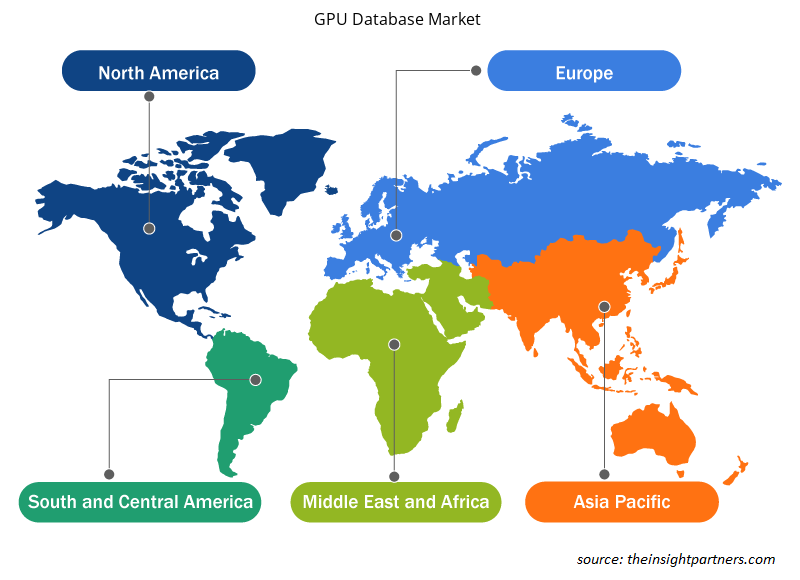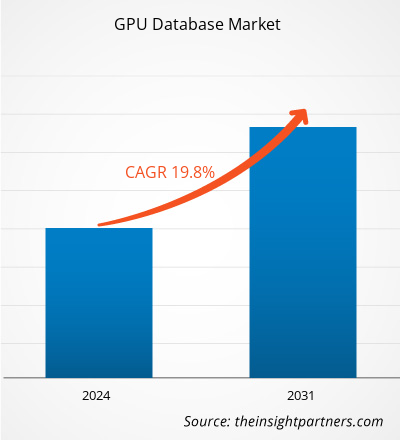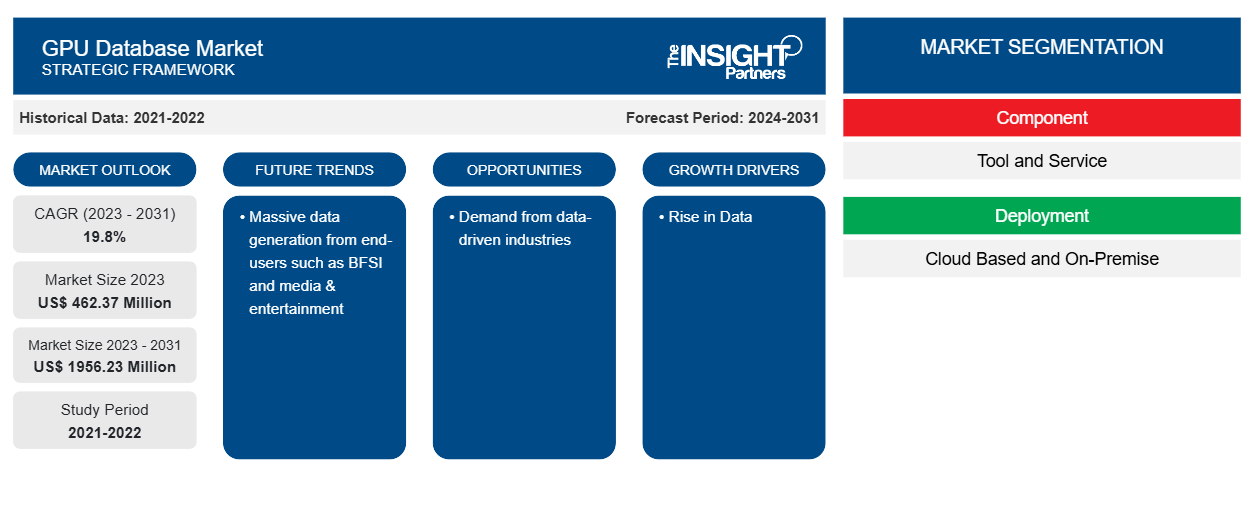La taille du marché des bases de données GPU devrait atteindre 1 956,23 millions de dollars américains d'ici 2031, contre 462,37 millions de dollars américains en 2023. Le marché devrait enregistrer un TCAC de 19,8 % au cours de la période 2023-2031. L'augmentation des données et la croissance des industries axées sur les données devraient rester des tendances clés du marché.CAGR of 19.8% during 2023–2031. The rise in data and the growing data-driven industries are likely to remain key trends in the market.
Analyse du marché des bases de données GPU
Les industries axées sur les données en pleine croissance sont l'un des principaux moteurs du marché des bases de données GPU. L'essor de la numérisation et la tendance des entreprises à se tourner vers des solutions permettant de traiter de grands ensembles de données alimentent la croissance du marché. La base de données GPU trouve son application dans certaines des technologies émergentes telles que l'intelligence artificielle, l'apprentissage automatique et profond, l'Internet des objets (IoT) et l'analyse géospatiale, ce qui crée d'énormes opportunités de croissance pour le marché des bases de données GPU.
Aperçu du marché des bases de données GPU
Une base de données GPU utilise des unités de traitement graphique (GPU) pour effectuer des opérations de base de données. Un GPU est un processeur programmable conçu pour restituer rapidement des images et des vidéos haute résolution. La base de données GPU traite d'énormes volumes de données plus rapidement et plus efficacement que les CPU, car elles fonctionnent en parallèle plutôt qu'en séquence. Ainsi, les bases de données GPU sont généralement plus rapides et orientées vers l'analyse, qui est plus flexible dans le traitement de nombreux types de données différents ou de quantités de données beaucoup plus importantes.
Personnalisez ce rapport en fonction de vos besoins
Vous bénéficierez d'une personnalisation gratuite de n'importe quel rapport, y compris de certaines parties de ce rapport, d'une analyse au niveau des pays, d'un pack de données Excel, ainsi que de superbes offres et réductions pour les start-ups et les universités.
- Obtenez les principales tendances clés du marché de ce rapport.Cet échantillon GRATUIT comprendra une analyse de données, allant des tendances du marché aux estimations et prévisions.
Moteurs et opportunités du marché des bases de données GPU
La hausse des données favorise le marché
Avec l'avènement de la numérisation, les données sont générées à un rythme effréné. Les données de différentes variétés, volumes et vitesses doivent être analysées et traitées pour mettre en évidence les modèles et les informations cachés à l'aide de techniques d'analyse de données . L'analyse traditionnelle ne parvient pas à fournir des techniques et des technologies d'analyse optimales. Cela génère le besoin d'une base de données GPU. Avec des capacités de traitement massivement parallèles, la base de données GPU fournit de manière rentable des calculs hautes performances. La base de données GPU est une solution idéale pour gérer de grands ensembles de données, ce qui stimule la demande pour cette technologie.
Demande des industries axées sur les données.
Les données GPU ont une puissance de calcul élevée. En raison de leurs capacités de traitement parallèle, elles peuvent traiter les données jusqu'à 100 fois plus rapidement que les configurations contenant uniquement des CPU, comme illustré. Ainsi, diverses industries axées sur les données telles que BFSI, les médias et le divertissement, et d'autres, exigent des solutions aux charges de travail à forte intensité de traitement pour les applications d'analyse de données, ce qui stimule la demande de bases de données GPU. Les acteurs du marché lancent des solutions pour répondre à cette demande. Graphistry a lancé Hub Pro (Graphistry Hub for Professionals) pour offrir aux clients une analyse graphique visuelle accélérée par GPU. Graphistry Hub Pro résout les problèmes de sécurité, de tarification et de maintenance pour les particuliers, et les prochaines organisations Hub pour les équipes. (Source : Graphistry, communiqué de presse, septembre 2021)CPUs, as illustrated. Thus, various data-driven industries such as BFSI, media & entertainment, and others demand solutions to processing-intensive workloads for data analytics applications, which drives the demand for GPU databases. The market players are launching solutions to cater to this demand. Graphistry launched Hub Pro (Graphistry Hub for Professionals) to bring GPU-accelerated visual graph analysis to customers. Graphistry Hub Pro solves security, pricing, and maintenance for individuals, and the upcoming Hub Organizations for teams. (Source: Graphistry, Press Release, September 2021)
Analyse de segmentation du rapport sur le marché des bases de données GPU
Les segments clés qui ont contribué à l’élaboration de l’analyse du marché des bases de données GPU sont les composants, le déploiement, l’application et le secteur vertical.
- En fonction des composants, le marché des bases de données GPU est divisé en outils et services. Le segment des outils détenait la plus grande part du marché en 2023.
- En termes de déploiement, le marché est segmenté en solutions basées sur le cloud et sur site. Les solutions basées sur le cloud devraient connaître le TCAC le plus élevé.CAGR.
- Par application, le marché est segmenté en détection et prévention de la fraude, gouvernance, risque et conformité (GRC), gestion de l'expérience client, maintenance prédictive, gestion de la chaîne d'approvisionnement, renseignement sur les menaces, etc. La gestion de l'expérience client détenait une part importante du marché en 2023.GRC), customer experience management, predictive maintenance, supply chain management, threat intelligence, and others. The customer experience management held a significant share of the market in 2023.
- Par secteur d'activité, le marché est segmenté en BFSI, informatique et télécommunications, vente au détail et commerce électronique, santé, transport et logistique, gouvernement et défense, etc. Le BFSI détenait une part importante du marché en 2023.BFSI, IT & telecom, retail & e-commerce, healthcare, transportation & logistics, government & defense, and others. The BFSI held a significant share of the market in 2023.
Analyse des parts de marché des bases de données GPU par zone géographique
La portée géographique du rapport sur le marché des bases de données GPU est principalement divisée en cinq régions : Amérique du Nord, Asie-Pacifique, Europe, Moyen-Orient et Afrique, et Amérique du Sud et centrale.
La région Asie-Pacifique devrait connaître le taux de croissance annuel composé le plus élevé. L’essor de la numérisation et la demande croissante de techniques avancées d’analyse de données dans les économies en développement telles que l’Inde et la Chine stimulent la croissance du marché dans la région. La transformation numérique dans les secteurs axés sur les données tels que le BFSI, la santé, la fabrication et d’autres, stimule encore davantage la croissance du marché. La demande croissante d’extraction d’informations à partir de grands ensembles de données alimente la croissance du marché en Asie-Pacifique.CAGR. The rise in digitalization and growing demand for advanced data analytics techniques in developing economies such as India and China is driving market growth in the region. Digital transformation across data-driven industries such as BFSI, healthcare, manufacturing, and others, further drives market growth. The increasing demand for extracting insights from large datasets is fuelling the market growth in Asia Pacific.
Aperçu régional du marché des bases de données GPU
Les tendances et facteurs régionaux influençant le marché des bases de données GPU tout au long de la période de prévision ont été expliqués en détail par les analystes d'Insight Partners. Cette section traite également des segments et de la géographie du marché des bases de données GPU en Amérique du Nord, en Europe, en Asie-Pacifique, au Moyen-Orient et en Afrique, ainsi qu'en Amérique du Sud et en Amérique centrale.

- Obtenez les données régionales spécifiques au marché des bases de données GPU
Portée du rapport sur le marché des bases de données GPU
| Attribut de rapport | Détails |
|---|---|
| Taille du marché en 2023 | 462,37 millions de dollars américains |
| Taille du marché d'ici 2031 | 1 956,23 millions de dollars américains |
| Taux de croissance annuel composé mondial (2023-2031) | 19,8% |
| Données historiques | 2021-2022 |
| Période de prévision | 2024-2031 |
| Segments couverts | Par composant
|
| Régions et pays couverts | Amérique du Nord
|
| Leaders du marché et profils d'entreprises clés |
|
Densité des acteurs du marché des bases de données GPU : comprendre son impact sur la dynamique des entreprises
Le marché des bases de données GPU connaît une croissance rapide, tirée par la demande croissante des utilisateurs finaux en raison de facteurs tels que l'évolution des préférences des consommateurs, les avancées technologiques et une plus grande sensibilisation aux avantages du produit. À mesure que la demande augmente, les entreprises élargissent leurs offres, innovent pour répondre aux besoins des consommateurs et capitalisent sur les tendances émergentes, ce qui alimente davantage la croissance du marché.
La densité des acteurs du marché fait référence à la répartition des entreprises ou des sociétés opérant sur un marché ou un secteur particulier. Elle indique le nombre de concurrents (acteurs du marché) présents sur un marché donné par rapport à sa taille ou à sa valeur marchande totale.
Les principales entreprises opérant sur le marché des bases de données GPU sont :
- BRYTLYT
- GRAPHISME
- H2O.ai
- Jedox
- Kinetica DB Inc.
- Neo4J, INC.
Avis de non-responsabilité : les sociétés répertoriées ci-dessus ne sont pas classées dans un ordre particulier.

- Obtenez un aperçu des principaux acteurs du marché des bases de données GPU
Actualités et développements récents du marché des bases de données GPU
Le marché des bases de données GPU est évalué en collectant des données qualitatives et quantitatives après des recherches primaires et secondaires, qui incluent d'importantes publications d'entreprise, des données d'association et des bases de données. Quelques-uns des développements du marché des bases de données GPU sont répertoriés ci-dessous :
- NVIDIA et HP Inc. ont annoncé l'intégration des bibliothèques de traitement de données NVIDIA CUDA-X aux solutions de station de travail HP AI pour dynamiser le travail de préparation et de traitement des données qui constitue la base du développement de l'IA générative. Construites sur la plateforme de calcul NVIDIA CUDA, les bibliothèques CUDA-X accélèrent le traitement des données pour une large gamme de types de données, notamment les tableaux, le texte, les images et la vidéo. Elles incluent la bibliothèque NVIDIA RAPIDS cuDF, qui accélère jusqu'à 110 fois le travail des près de 10 millions de data scientists utilisant le logiciel pandas en utilisant un GPU NVIDIA RTX 6000 de génération Ada au lieu d'un système uniquement CPU, sans nécessiter de modifications de code. (Source : NVIDIA, communiqué de presse, mars 2024)
- Zilliz, un pionnier de la technologie des bases de données vectorielles , a annoncé la sortie de Milvus 2.4, établissant une nouvelle norme en matière de capacités de recherche vectorielle avec une fonction d'indexation GPU révolutionnaire alimentée par CUDA-Accelerated Graph Index for Vector Retrieval (CAGRA) de NVIDIA, qui fait partie de la bibliothèque RAPIDS cuVS. (Source : Zilliz, communiqué de presse, mars 2024)
Rapport sur le marché des bases de données GPU : couverture et livrables
Le rapport « Taille et prévisions du marché des bases de données GPU (2021-2031) » fournit une analyse détaillée du marché couvrant les domaines ci-dessous :
- Taille et prévisions du marché des bases de données GPU aux niveaux mondial, régional et national pour tous les segments de marché clés couverts par le périmètre
- Tendances du marché des bases de données GPU ainsi que dynamique du marché telles que les moteurs, les contraintes et les opportunités clés
- Analyse détaillée des cinq forces de PEST/Porter et SWOT
- Analyse du marché des bases de données GPU couvrant les principales tendances du marché, le cadre mondial et régional, les principaux acteurs, les réglementations et les développements récents du marché
- Analyse du paysage industriel et de la concurrence couvrant la concentration du marché, l'analyse de la carte thermique, les principaux acteurs et les développements récents pour le marché des bases de données GPU
- Profils d'entreprise détaillés
- Analyse historique (2 ans), année de base, prévision (7 ans) avec TCAC
- Analyse PEST et SWOT
- Taille du marché Valeur / Volume - Mondial, Régional, Pays
- Industrie et paysage concurrentiel
- Ensemble de données Excel
Rapports récents
Témoignages
Raison d'acheter
- Prise de décision éclairée
- Compréhension de la dynamique du marché
- Analyse concurrentielle
- Connaissances clients
- Prévisions de marché
- Atténuation des risques
- Planification stratégique
- Justification des investissements
- Identification des marchés émergents
- Amélioration des stratégies marketing
- Amélioration de l'efficacité opérationnelle
- Alignement sur les tendances réglementaires























 Obtenez un échantillon gratuit pour - Marché des bases de données GPU
Obtenez un échantillon gratuit pour - Marché des bases de données GPU